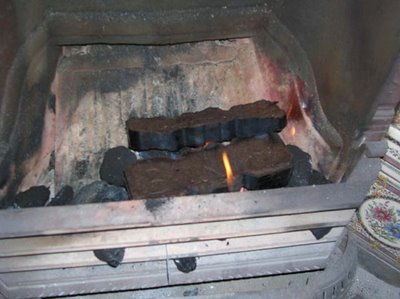I grew up around coal stoves, but the coal we burn here in Northeastern Pennsylvania is anthracite, the shiny "hard" coal that burns hot and clean. In Ireland the coal that I saw was bituminous, mostly from Poland, although the really good stuff was from Colombia. (Which seems like a long way to import coal - but hey, energy imports can be a funny thing.) The pieces of coal are roughly the size of potatoes, across the entire size range of potatoes, from smallish pieces the size of a golf ball to chunks bigger than my fist. Bituminous is dusty and gives off more smoke when it burns than anthracite. It also makes a greasy-sounding crackle when it burns - you almost expect it to feel greasy, but it doesn't.
 You can buy the coal at most gas (sorry, "petrol") stations and in front of a lot of supermarkets, or from the friendly coal delivery guy who drives around town. The coal doesn't light easily, so building a fire is usually a two- or three-step process. You generally start by lighting a bit of compressed peat, harvested from Ireland's many peat bogs. Peat is sold in bundles of bricks (on the red rack on the left in the above picture). You split each brick into thinner layers by banging it against something hard. Peat will burn well and is usually a good starter for getting the coal burning, although sometimes the peat will simply flare up and burn out without doing anything to the coal. Sometimes the peat is difficult to light and you need to resort to firelighters to get it started. Firelighters come in a variety of forms, but the most common ones I've seen look like pieces of compressed shredded paper and smell like kerosene.
You can buy the coal at most gas (sorry, "petrol") stations and in front of a lot of supermarkets, or from the friendly coal delivery guy who drives around town. The coal doesn't light easily, so building a fire is usually a two- or three-step process. You generally start by lighting a bit of compressed peat, harvested from Ireland's many peat bogs. Peat is sold in bundles of bricks (on the red rack on the left in the above picture). You split each brick into thinner layers by banging it against something hard. Peat will burn well and is usually a good starter for getting the coal burning, although sometimes the peat will simply flare up and burn out without doing anything to the coal. Sometimes the peat is difficult to light and you need to resort to firelighters to get it started. Firelighters come in a variety of forms, but the most common ones I've seen look like pieces of compressed shredded paper and smell like kerosene. Here are some slabs of peat starting to light up in the fireplace. After these are fully involved you put some coal on top of the burning peat and hope for the best. (Sometimes dumping the coal is the best way to get the fire going, since any coal dust at the bottom of the scuttle will start burning very quickly.)
Here are some slabs of peat starting to light up in the fireplace. After these are fully involved you put some coal on top of the burning peat and hope for the best. (Sometimes dumping the coal is the best way to get the fire going, since any coal dust at the bottom of the scuttle will start burning very quickly.) A fire starting to burn in my friend's fireplace. Once the fire is fully involved it gives off a cheerful warmth that is most beneficial to someone sitting very close to the fireplace. The fireplace is apparently iron, including the upper portions. Note the ornate tilework on either side of the fireplace, the fire screen off to the left, and the brass coal scuttle on the right. The peat and coal give off a characteristic smell very much like charcoal burning on a barbecue grill. Often in the Summer I will get a whiff of someone in my neighborhood getting ready to grill steaks outdoors and I will find myself taken back to a cold Winter or Spring day sitting beside a coal fire at my friend's place in Ireland.
A fire starting to burn in my friend's fireplace. Once the fire is fully involved it gives off a cheerful warmth that is most beneficial to someone sitting very close to the fireplace. The fireplace is apparently iron, including the upper portions. Note the ornate tilework on either side of the fireplace, the fire screen off to the left, and the brass coal scuttle on the right. The peat and coal give off a characteristic smell very much like charcoal burning on a barbecue grill. Often in the Summer I will get a whiff of someone in my neighborhood getting ready to grill steaks outdoors and I will find myself taken back to a cold Winter or Spring day sitting beside a coal fire at my friend's place in Ireland.























1 comment:
Check out my blog,tales from Ozlaid house(a Cork nightmare).Its progress is ongoing.
Post a Comment